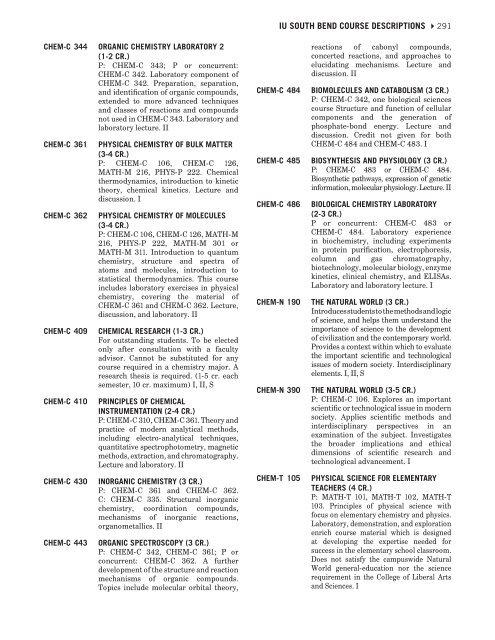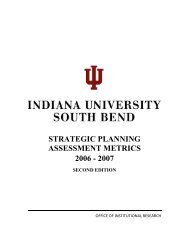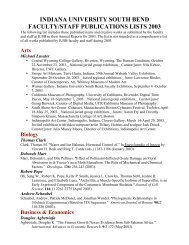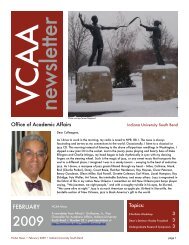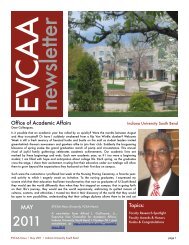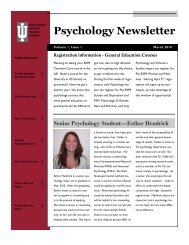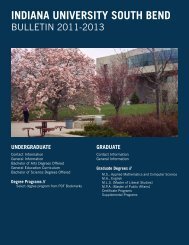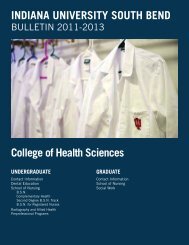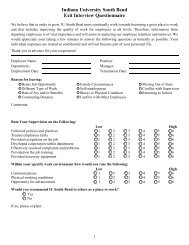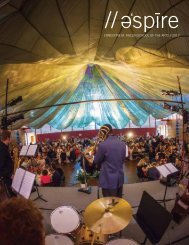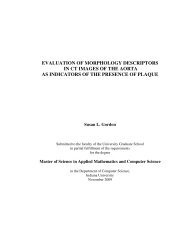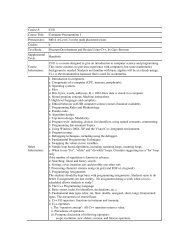INDIANA UNIVERSITY SOUTH BEND Course Descriptions
INDIANA UNIVERSITY SOUTH BEND Course Descriptions
INDIANA UNIVERSITY SOUTH BEND Course Descriptions
Create successful ePaper yourself
Turn your PDF publications into a flip-book with our unique Google optimized e-Paper software.
IU <strong>SOUTH</strong> <strong>BEND</strong> COURSE DESCRIPTIONS 4291<br />
CHEM-C 344 ORGANIC CHEMISTRY LABORATORY 2<br />
(1-2 CR.)<br />
P: CHEM-C 343; P or concurrent:<br />
CHEM-C 342. Laboratory component of<br />
CHEM-C 342. Preparation, separation,<br />
and identification of organic compounds,<br />
extended to more advanced techniques<br />
and classes of reactions and compounds<br />
not used in CHEM-C 343. Laboratory and<br />
laboratory lecture. II<br />
CHEM-C 361<br />
CHEM-C 362<br />
CHEM-C 409<br />
CHEM-C 410<br />
CHEM-C 430<br />
CHEM-C 443<br />
PHYSICAL CHEMISTRY OF BULK MATTER<br />
(3-4 CR.)<br />
P: CHEM-C 106, CHEM-C 126,<br />
MATH-M 216, PHYS-P 222. Chemical<br />
thermodynamics, introduction to kinetic<br />
theory, chemical kinetics. Lecture and<br />
discussion. I<br />
PHYSICAL CHEMISTRY OF MOLECULES<br />
(3-4 CR.)<br />
P: CHEM-C 106, CHEM-C 126, MATH-M<br />
216, PHYS-P 222, MATH-M 301 or<br />
MATH-M 311. Introduction to quantum<br />
chemistry, structure and spectra of<br />
atoms and molecules, introduction to<br />
statistical thermodynamics. This course<br />
includes laboratory exercises in physical<br />
chemistry, covering the material of<br />
CHEM-C 361 and CHEM-C 362. Lecture,<br />
discussion, and laboratory. II<br />
CHEMICAL RESEARCH (1-3 CR.)<br />
For outstanding students. To be elected<br />
only after consultation with a faculty<br />
advisor. Cannot be substituted for any<br />
course required in a chemistry major. A<br />
research thesis is required. (1-5 cr. each<br />
semester, 10 cr. maximum) I, II, S<br />
PRINCIPLES OF CHEMICAL<br />
INSTRUMENTATION (2-4 CR.)<br />
P: CHEM-C 310, CHEM-C 361. Theory and<br />
practice of modern analytical methods,<br />
including electro-analytical techniques,<br />
quantitative spectrophotometry, magnetic<br />
methods, extraction, and chromatography.<br />
Lecture and laboratory. II<br />
INORGANIC CHEMISTRY (3 CR.)<br />
P: CHEM-C 361 and CHEM-C 362.<br />
C: CHEM-C 335. Structural inorganic<br />
chemistry, coordination compounds,<br />
mechanisms of inorganic reactions,<br />
organometallics. II<br />
ORGANIC SPECTROSCOPY (3 CR.)<br />
P: CHEM-C 342, CHEM-C 361; P or<br />
concurrent: CHEM-C 362. A further<br />
development of the structure and reaction<br />
mechanisms of organic compounds.<br />
Topics include molecular orbital theory,<br />
CHEM-C 484<br />
CHEM-C 485<br />
CHEM-C 486<br />
CHEM-N 190<br />
CHEM-N 390<br />
CHEM-T 105<br />
reactions of cabonyl compounds,<br />
concerted reactions, and approaches to<br />
elucidating mechanisms. Lecture and<br />
discussion. II<br />
BIOMOLECULES AND CATABOLISM (3 CR.)<br />
P: CHEM-C 342, one biological sciences<br />
course Structure and function of cellular<br />
components and the generation of<br />
phosphate-bond energy. Lecture and<br />
discussion. Credit not given for both<br />
CHEM-C 484 and CHEM-C 483. I<br />
BIOSYNTHESIS AND PHYSIOLOGY (3 CR.)<br />
P: CHEM-C 483 or CHEM-C 484.<br />
Biosynthetic pathways, expression of genetic<br />
information, molecular physiology. Lecture. II<br />
BIOLOGICAL CHEMISTRY LABORATORY<br />
(2-3 CR.)<br />
P or concurrent: CHEM-C 483 or<br />
CHEM-C 484. Laboratory experience<br />
in biochemistry, including experiments<br />
in protein purification, electrophoresis,<br />
column and gas chromatography,<br />
biotechnology, molecular biology, enzyme<br />
kinetics, clinical chemistry, and ELISAs.<br />
Laboratory and laboratory lecture. I<br />
THE NATURAL WORLD (3 CR.)<br />
Introduces students to the methods and logic<br />
of science, and helps them understand the<br />
importance of science to the development<br />
of civilization and the contemporary world.<br />
Provides a context within which to evaluate<br />
the important scientific and technological<br />
issues of modern society. Interdisciplinary<br />
elements. I, II, S<br />
THE NATURAL WORLD (3-5 CR.)<br />
P: CHEM-C 106. Explores an important<br />
scientific or technological issue in modern<br />
society. Applies scientific methods and<br />
interdisciplinary perspectives in an<br />
examination of the subject. Investigates<br />
the broader implications and ethical<br />
dimensions of scientific research and<br />
technological advancement. I<br />
PHYSICAL SCIENCE FOR ELEMENTARY<br />
TEACHERS (4 CR.)<br />
P: MATH-T 101, MATH-T 102, MATH-T<br />
103. Principles of physical science with<br />
focus on elementary chemistry and physics.<br />
Laboratory, demonstration, and exploration<br />
enrich course material which is designed<br />
at developing the expertise needed for<br />
success in the elementary school classroom.<br />
Does not satisfy the campuswide Natural<br />
World general-education nor the science<br />
requirement in the College of Liberal Arts<br />
and Sciences. I


